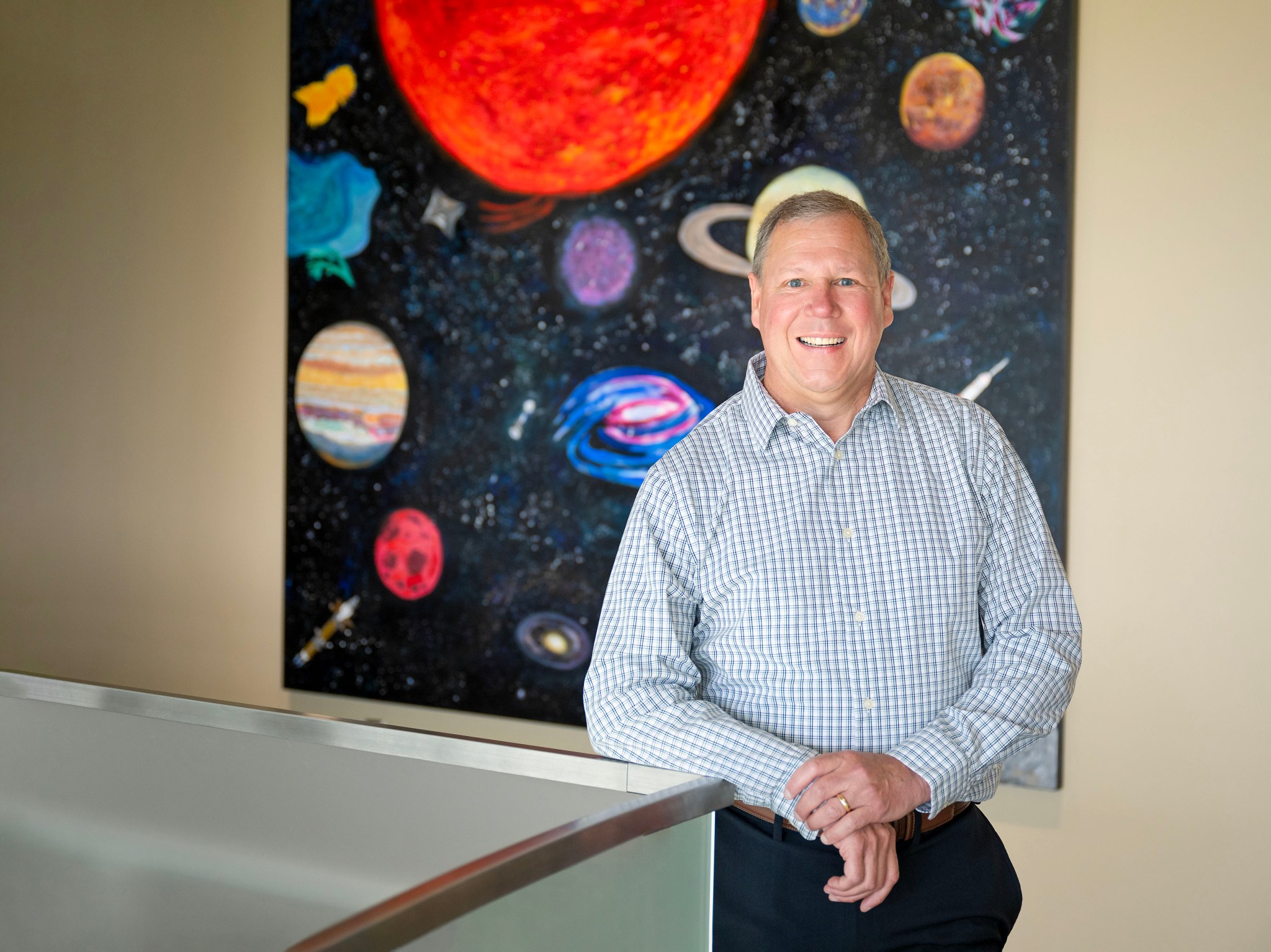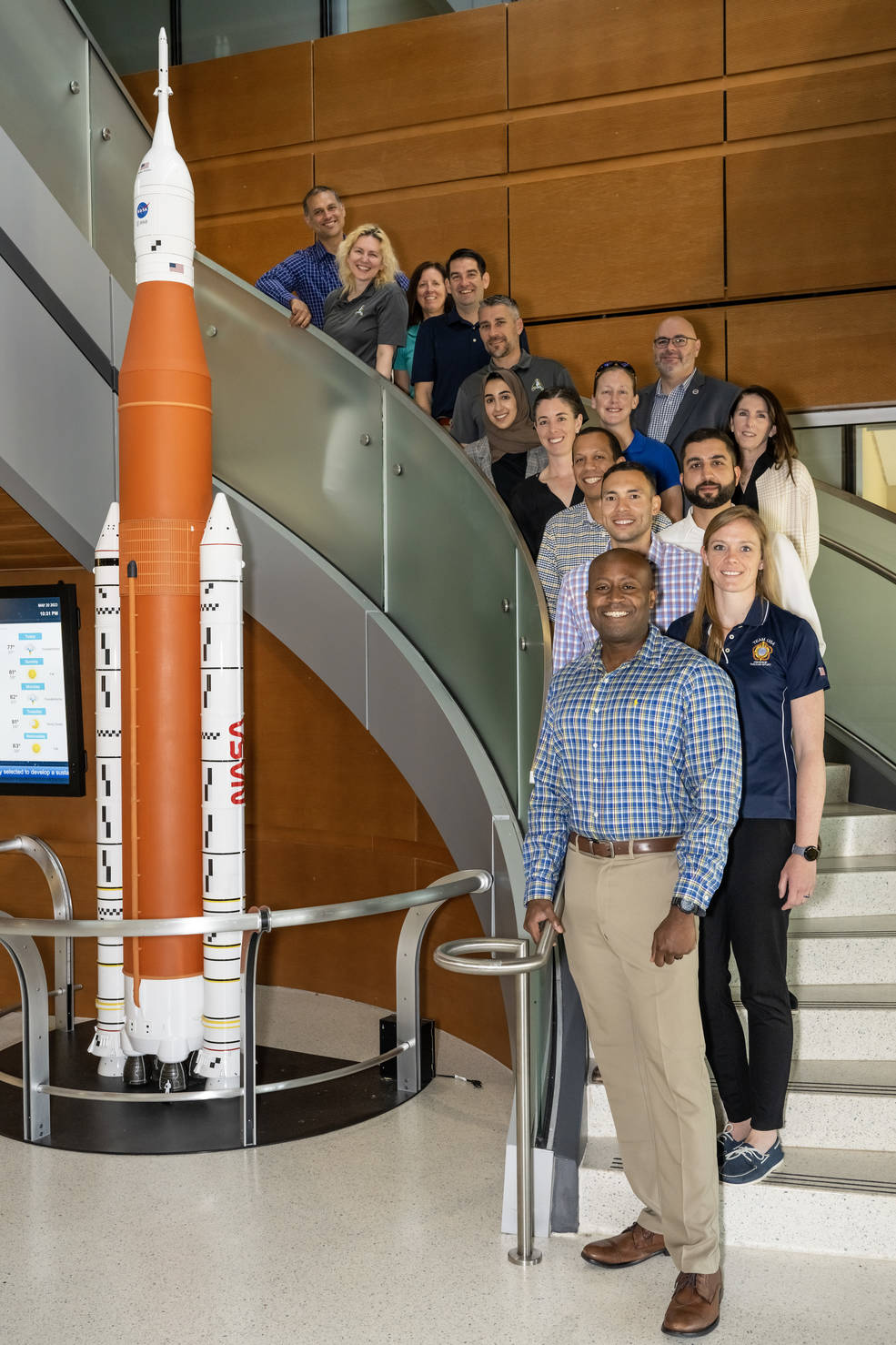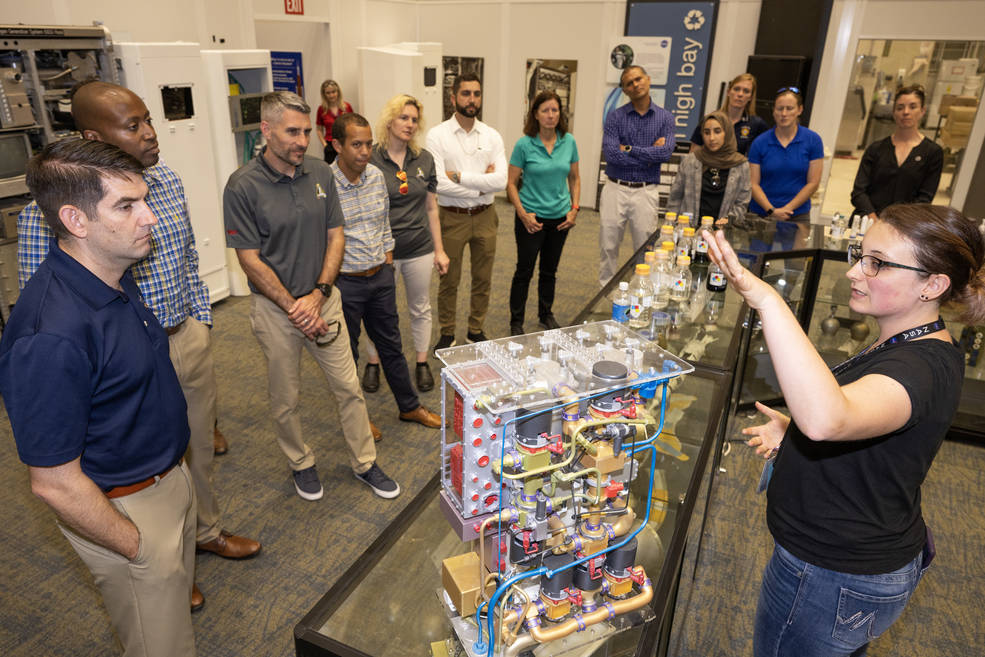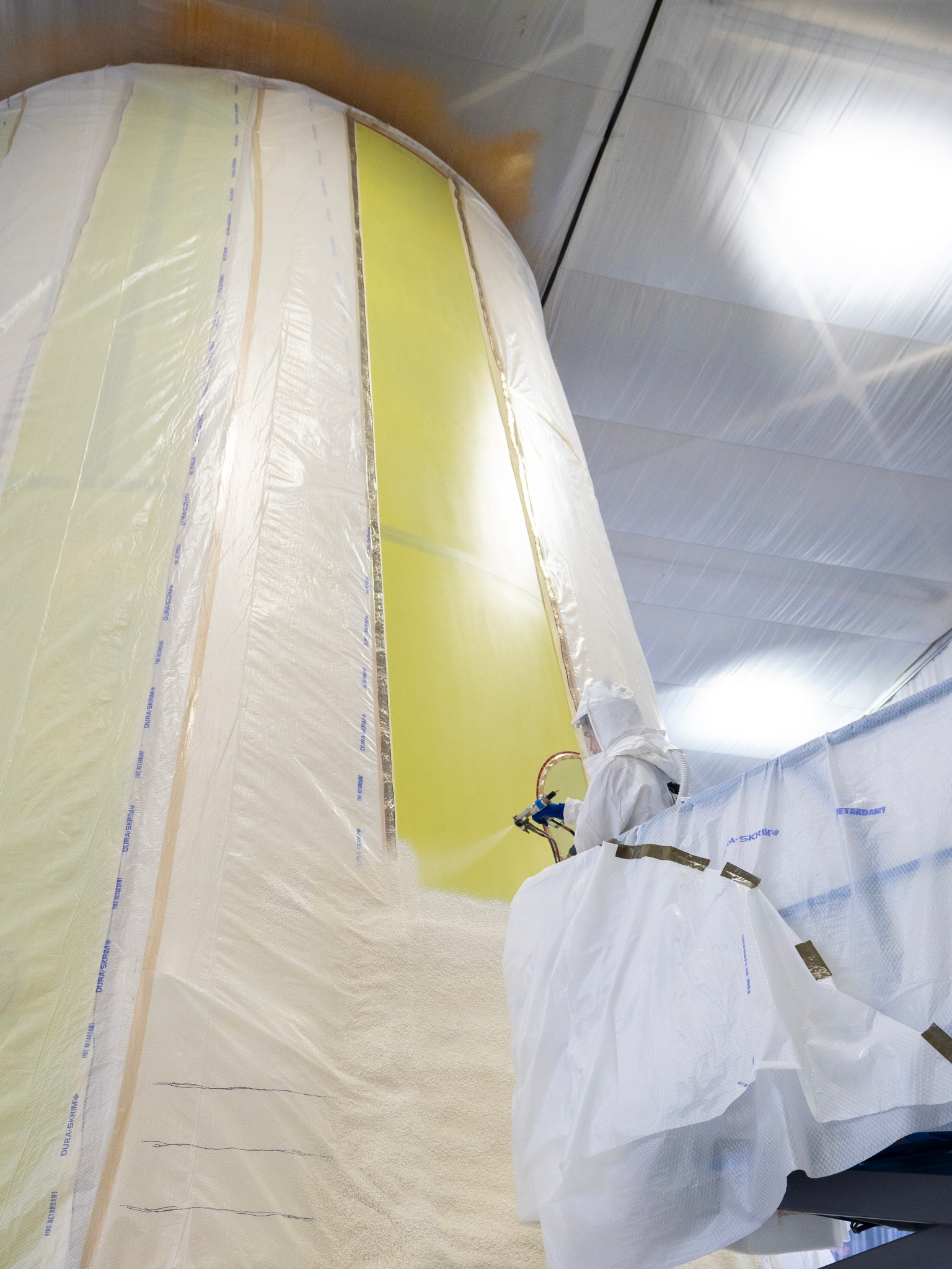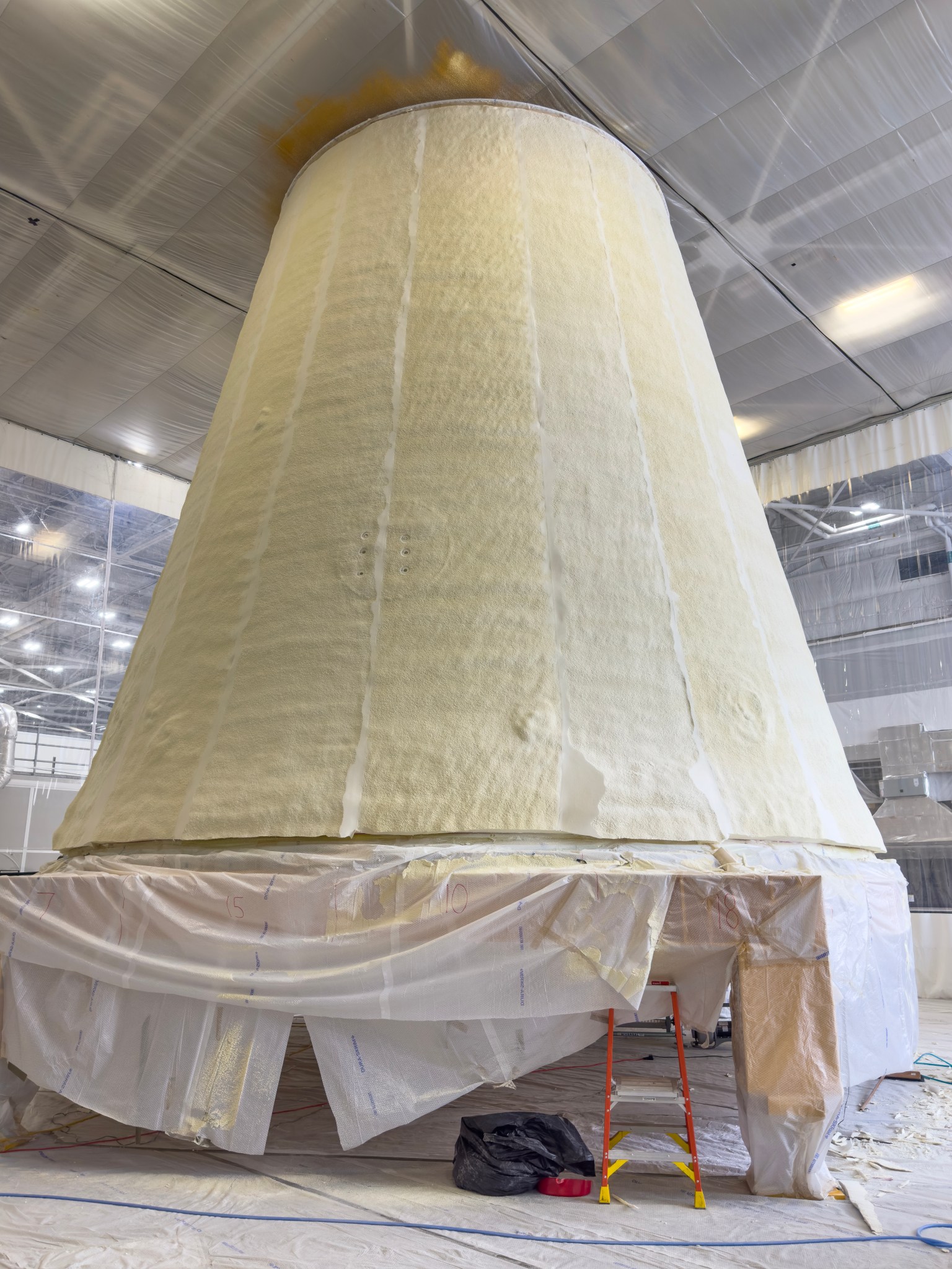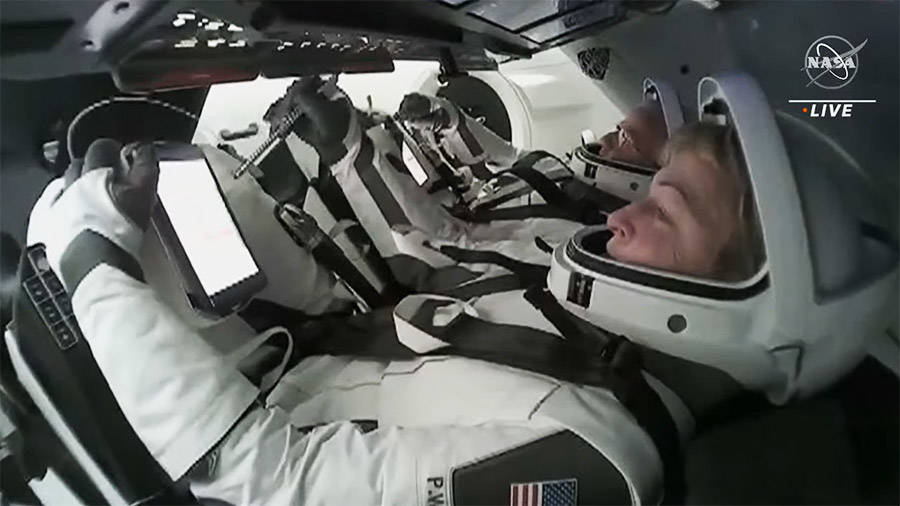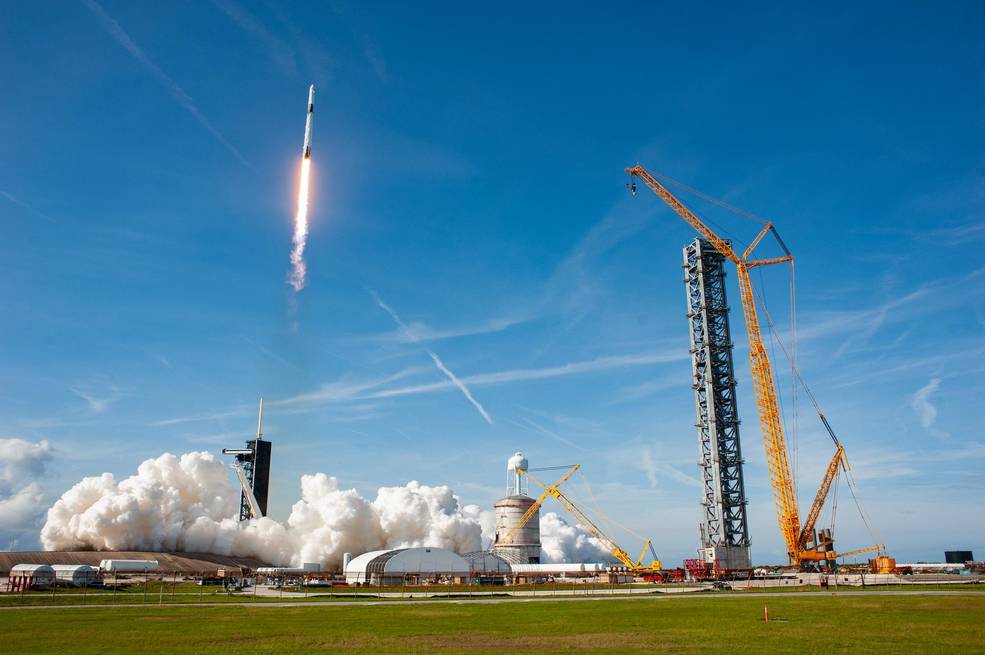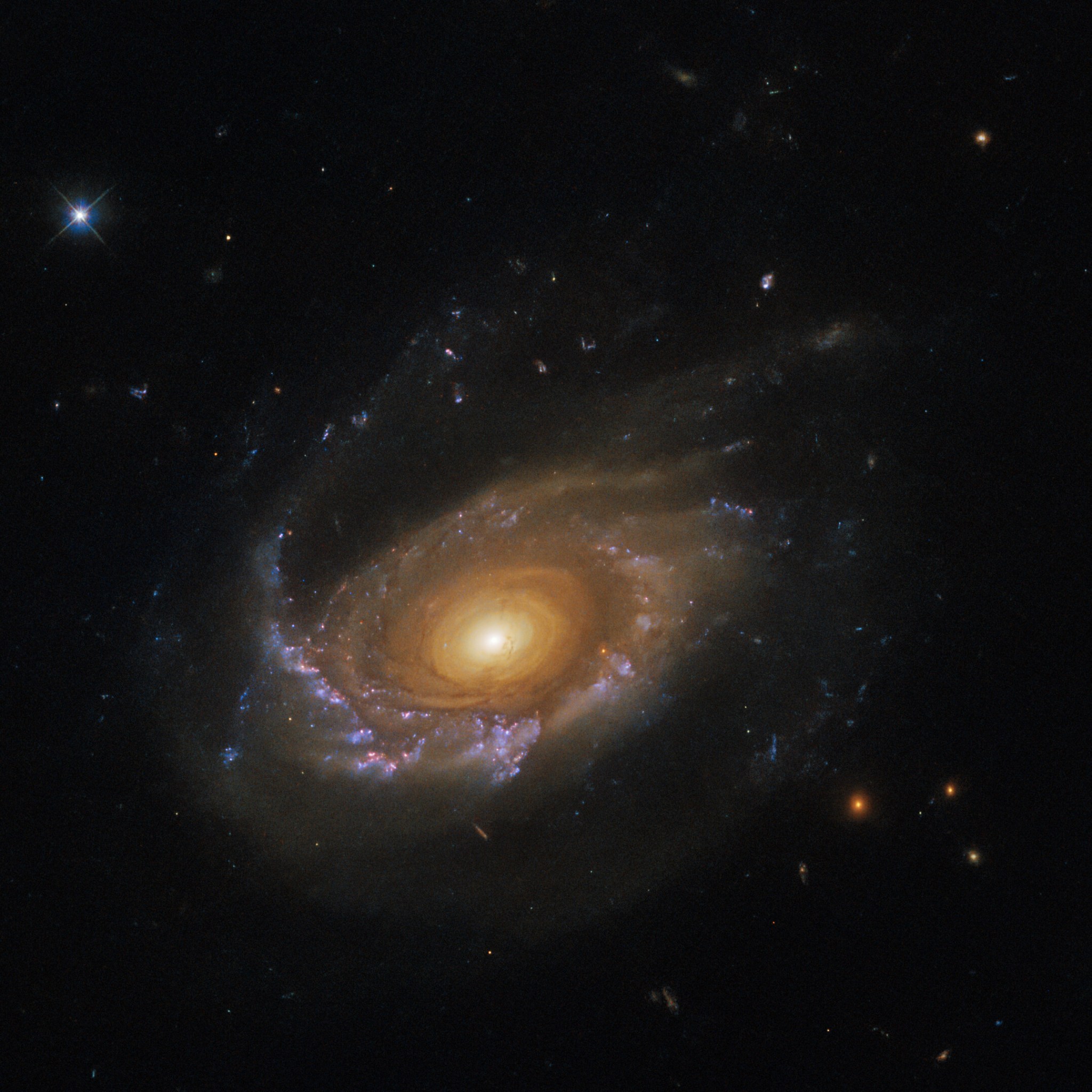The Marshall Star for May 24, 2023.
In This Week’s Star
- Take 5: Mark Richards
- Astronaut Candidates Explore Marshall’s Role in NASA Missions
- Technicians Apply Thermal Protection Material to NASA Moon Rocket Hardware
- Station Crew Focuses on Spacewalks, Cargo Mission After Ax-2
- NASA Sets Coverage for Next SpaceX Resupply Launch to Space Station
- Hubble Captures a Drifting Galaxy
- Webb Maps Surprisingly Large Plume Jetting from Saturn’s Moon Enceladus
Take 5: Mark Richards
By Wayne Smith
Mark Richards grew up in the shadow of NASA’s Marshall Space Flight Center, with his father’s work as a contractor for the agency during the Apollo program bringing the family to Huntsville in 1970.
Pursuing a career at NASA seemed like a natural fit for Richards, deputy director of the Office of Strategic Analysis and Communications (OSAC) at Marshall. He said his parents were the inspiration for him toward earning his degree in electrical engineering at the University of Notre Dame and following his career path with NASA.
“My mother and father are the children of a railroad worker and a steel mill worker,” Richards said. “They were also both first-generation college graduates. Through my parents, I learned the value of a formal education along with the ethic of honest work.”
Richards said the work ethic his parents exemplified continues to serve as motivation for him in his role at Marshall.
“I enjoy analyzing and understanding how complex systems interact, including the people that are a part of those systems,” he said. “I feel great when I’m able to facilitate a common vision of a problem and provide structure that allows groups and/or individuals to bring their skills together to solve it. I’m wired to be a ‘behind the scenes’ kind of leader, so I feel a sense of accomplishment when the team is successful.”
Question: What are your primary responsibilities as deputy director for OSAC?
Richards: In this role, I share leadership responsibility to provide the integrated strategies, structures, processes, and communications that enable Marshall to contribute to NASA’s missions through the application of the center’s core capabilities and assigned agency roles and responsibilities.
Question: What excites you most about the future of human space exploration and your team’s role it?
Richards: Human space exploration offers tremendous benefits to our country and the world. The emerging technologies needed to go beyond cislunar space, the cooperation needed to build the systems to get there, and the scientific discoveries that will be made are wrapped together in a visible and inspirational campaign that can be shared. In OSAC, we integrate efforts that cross many of the organizations and functions that Marshall contributes to human exploration programs and projects. Through our matrixed communications and STEM (science, technology, engineering, and math)-related organizations, we share our plans and accomplishments with the Marshall community and the public while we inspire the next generation.
Question: What has been the proudest moment of your career and why?
Richards: At a reception following a Marshall awards ceremony, I had the opportunity to meet the parents of one of my employees who received an award. I was humbled by how warmly they greeted me and surprised by how much they knew about me. From my discussions at work, I knew that this employee had been going through a difficult time in their life, but I had not realized that, over time, I had provided the consistent listening ear and encouragement the team member really needed. Having that employee’s parents thank me for the positive impact I had on their child’s life really brought home how important it is to be empathetic and take care of your people. That exchange left me feeling that I had made a difference as a leader and validated the type of work environment I try to create.
Question: What advice do you have for employees early in their NASA career or those in new leadership roles?
Richards: I feel that having a broad set of skills is as important as having depth in a few disciplines. When you consider the many ways we accomplish our work, experience in fields like Program Planning and Controls (PP&C) or Procurement and Resource Management, are just as valuable as solid technical skills. So, my advice is to take advantage of the formal training and the flexibility we enjoy as NASA employees. A detail assignment outside your current job is a great way to gain new skills, experience, and exposure. Finally, don’t be afraid to take on a new role when you get too comfortable with what you are doing. It’s the only way you continue to grow.
Question: What do you enjoy doing with your time while away from work?
Richards: I’ve always enjoyed staying active and learning. I play ice hockey in the local adult leagues a couple nights a week. I enjoy reading, primarily history, biographies, and psychology. I play a little guitar. Over the past few years, I’ve put a lot of time and effort into becoming a private pilot, and I’m currently finishing my instrument rating.
Smith, a Media Fusion employee and the Marshall Star editor, supports Marshall’s Office of Strategic Analysis & Communications.
Astronaut Candidates Explore Marshall’s Role in NASA Missions
NASA’s 2021 astronaut candidates class took a group photo during their visit to Marshall Space Flight Center on May 24 with the center’s senior leaders, Joseph Pelfrey and Rae Ann Meyer, in Building 4221. The group also included two United Arab Emirates astronauts, Nora Almatrooshi and Mohammad Almulla, who are training with NASA. The visit featured meetings with Marshall leaders, overviews of the Space Launch System and Human Landing System programs, and facility visits to learn about the Systems Integration Lab, Space Nuclear Propulsion, Environmental Control and Life Support System, Launch Vehicle Stage Adapter III, and more. (NASA/Mick Speer)
Marshall team memberKaitlin Oliver-Butler briefs members of the 2021 astronaut candidate class on the Environmental Control and Life Support System. ECLSS is a system of regenerative life support hardware that provides clean air and water on the International Space Station. (NASA/Mick Speer)
Marshall team member Darrell Bailey, left, explains the center’s work in the System Integration Lab to astronaut candidates. The lab includes flight computers and avionics identical to the core stage avionics for NASA’s Space Launch System rocket. (NASA/Mick Speer)
Technicians Apply Thermal Protection Material to NASA Moon Rocket Hardware
Technicians at NASA’s Marshall Space Flight Center have completed applying thermal protection system material to the launch vehicle stage adapter (LVSA) of NASA’s SLS (Space Launch System) rocket for Artemis III, which will land astronauts on the Moon to advance long-term lunar exploration and scientific discovery and inspire the Artemis Generation. The LVSA is a cone-shaped element connecting the mega rocket’s core stage to its interim cryogenic propulsion stage (ICPS), partially enclosing it and protecting its avionics and electrical systems from the extreme pressures, sounds, and temperatures during launch and flight. Teams at Marshall began applying the thermal protection system material earlier this spring. Unlike other parts of the SLS rocket, the thermal protection system material for the LVSA is applied entirely by hand using a spray gun. During application, the technicians use a thin measuring rod to gauge the proper thickness. Once the material has cured, certain areas are sanded down to meet parameters. The entire process takes several months. The LVSA is fully manufactured at Marshall by NASA, lead contractor Teledyne Brown Engineering, and the Jacobs Space Exploration Group’s ESSCA contract. The LVSA for Artemis III is the last of its kind as the future SLS rockets will transition to its next, more powerful Block 1B configuration beginning with Artemis IV. (NASA/Brandon Hancock)
Station Crew Focuses on Spacewalks, Cargo Mission After Ax-2
The seven Expedition 69 crew members are turning their attention to a pair of spacewalks and a cargo mission after saying goodbye to their Axiom Mission-2 (Ax-2) guests on May 30. Meanwhile, a pair of experiments onboard the International Space Station on May 31 looked at monitoring health and 3D printing.
The four astronauts and three cosmonauts that comprise Expedition 69 resumed their standard mission activities following the departure of four Ax-2 astronauts. Next up in June for the orbital residents are a pair of spacewalks to upgrade the station’s power generation system and a commercial resupply mission.
Mission managers will preview the upcoming power upgrade spacewalks during a news conference live on NASA TV at 11 a.m. CDT on June 1. The first spacewalk will begin at 8:15 a.m. on June 9 with NASA flight engineers Stephen Bowen and Woody Hoburg. The duo will exit the Quest airlock in their Extravehicular Mobility Units (EMUs), or spacesuits, and install a new roll-out solar array on the orbital lab’s starboard-side truss segment. The second spacewalk will take place on June 15 with the duo going back out in their EMUs and installing another roll-out solar array on the starboard truss.
The SpaceX Dragon spacecraft undocked from the space-facing port of the International Space Station’s Harmony module at 10:05 a.m. CDT on May 30 to complete the second all-private astronaut mission to the orbiting laboratory, Axiom Mission 2 (Ax-2).
NASA Sets Coverage for Next SpaceX Resupply Launch to Space Station
NASA and SpaceX are targeting 11:35 a.m. CDT June 3 to launch the company’s 28th commercial resupply services mission to the International Space Station from Launch Complex 39A at the agency’s Kennedy Space Center.
Live launch coverage will air on NASA Television, the NASA app, and the agency’s website, with prelaunch events starting June 2. Follow all events here.
SpaceX’s Dragon will deliver new science investigations, food, supplies, and equipment for the international crew, including the next pair of IROSAs (International Space Station Roll Out Solar Arrays). The solar panels, which roll out using stored kinetic energy, will expand the energy-production capabilities of the space station. This will be the fifth and sixth IROSAs launching in a SpaceX Dragon’s trunk. Each new IROSA will produce more than 20 kilowatts of electricity, and once all are installed, will enable a 30% increase in power production over the station’s current arrays.
Arrival at the station is scheduled for 4:36 a.m. June 5. The SpaceX Dragon spacecraft will dock autonomously to the station’s zenith port of the Harmony module.
The spacecraft is expected to spend about a month attached to the orbiting outpost before it returns to Earth with research and return cargo, splashing down off the coast of Florida.
Hubble Captures a Drifting Galaxy
The jellyfish galaxy JW39 hangs serenely in this image from the NASA/ESA Hubble Space Telescope. This galaxy lies over 900 million light-years away in the constellation Coma Berenices and is one of several jellyfish galaxies Hubble has been studying over the past two years. Despite this jellyfish galaxy’s serene appearance, it is adrift in a ferociously hostile environment: a galaxy cluster. Compared to their more isolated counterparts, the galaxies in galaxy clusters are often distorted by the gravitational pull of larger neighbors, which can twist galaxies into a variety of shapes. If that was not enough, the space between galaxies in a cluster is also pervaded with a searingly hot plasma known as the intracluster medium. While this plasma is extremely tenuous, galaxies moving through it experience it almost like swimmers fighting against a current, and this interaction can strip galaxies of their star-forming gas. This interaction between the intracluster medium and the galaxies is called ram-pressure stripping and is the process responsible for the trailing tendrils of this jellyfish galaxy. As JW39 moved through the cluster, the pressure of the intracluster medium stripped away gas and dust into long trailing ribbons of star formation that now stretch away from the disk of the galaxy. Astronomers using Hubble’s Wide Field Camera 3 studied these trailing tendrils in detail, as they are a particularly extreme environment for star formation. Surprisingly, they found that star formation in the “tentacles” of jellyfish galaxies was not noticeably different from star formation in the galaxy disk. (Text credit: European Space Agency (ESA). Image credit: ESA/Hubble & NASA, M. Gullieuszik and the GASP team)
Webb Maps Surprisingly Large Plume Jetting from Saturn’s Moon Enceladus
A water vapor plume from Saturn’s moon Enceladus spanning more than 6,000 miles – nearly the distance from Los Angeles, California to Buenos Aires, Argentina – has been detected by researchers using NASA’s James Webb Space Telescope. Not only is this the first time such a water emission has been seen over such an expansive distance, but Webb is also giving scientists a direct look, for the first time, at how this emission feeds the water supply for the entire system of Saturn and its rings.
Enceladus, an ocean world about four percent the size of Earth, just 313 miles across, is one of the most exciting scientific targets in our solar system in the search for life beyond Earth. Sandwiched between the moon’s icy outer crust and its rocky core is a global reservoir of salty water. Geyser-like volcanos spew jets of ice particles, water vapor, and organic chemicals out of crevices in the moon’s surface informally called ‘tiger stripes.’
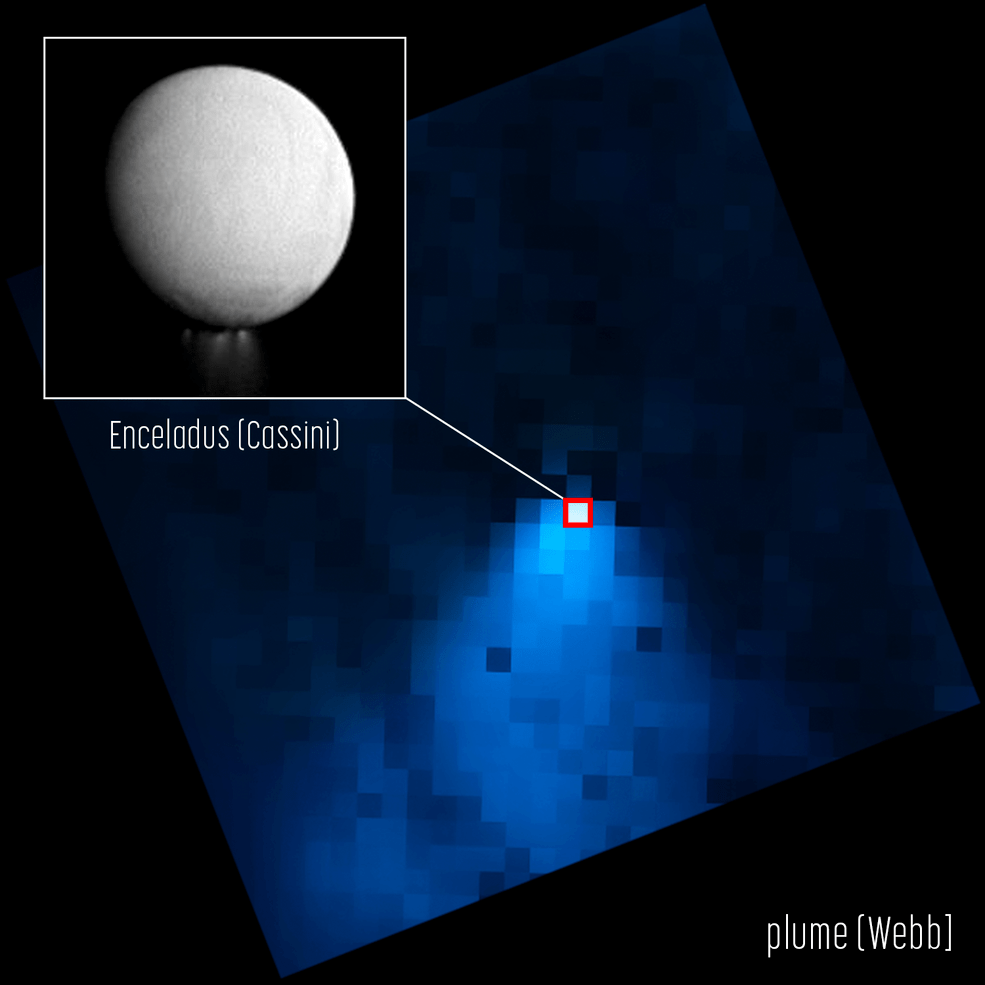
Previously, observatories have mapped jets hundreds of miles from the moon’s surface, but Webb’s exquisite sensitivity reveals a new story.
“When I was looking at the data, at first, I was thinking I had to be wrong. It was just so shocking to detect a water plume more than 20 times the size of the moon,” said lead author Geronimo Villanueva of NASA’s Goddard Space Flight Center. “The water plume extends far beyond its release region at the southern pole.”
The length of the plume was not the only characteristic that intrigued researchers. The rate at which the water vapor is gushing out, about 79 gallons per second, is also particularly impressive. At this rate, you could fill an Olympic-sized swimming pool in just a couple of hours. In comparison, doing so with a garden hose on Earth would take more than 2 weeks.
The Cassini orbiter spent over a decade exploring the Saturnian system, and not only imaged the plumes of Enceladus for the first time but flew directly through them and sampled what they were made of. While Cassini’s position within the Saturnian system provided invaluable insights into this distant moon, Webb’s unique view from the Sun-Earth Lagrange Point 2 one million miles from Earth, along with the remarkable sensitivity of its Integral Field Unit aboard the NIRSpec (Near-Infrared Spectrograph) Instrument, is offering new context.
“The orbit of Enceladus around Saturn is relatively quick, just 33 hours. As it whips around Saturn, the moon and its jets are basically spitting off water, leaving a halo, almost like a donut, in its wake,” said Villanueva. “In the Webb observations, not only was the plume huge, but there was just water absolutely everywhere.”
This fuzzy donut of water that appeared ‘everywhere,’ described as a torus, is co-located with Saturn’s outermost and widest ring – the dense “E-ring.”
The Webb observations directly demonstrate how the moon’s water vapor plumes feed the torus. By analyzing the Webb data, astronomers have determined roughly 30 percent of the water stays within this torus, and the other 70 percent escapes to supply the rest of the Saturnian system of water.
In the coming years, Webb will serve as the primary observation tool for ocean moon Enceladus, and discoveries from Webb will help inform future solar system satellite missions that will look to explore the subsurface ocean’s depth, how thick the ice crust is, and more.
“Right now, Webb provides a unique way to directly measure how water evolves and changes over time across Enceladus’ immense plume, and as we see here, we will even make new discoveries and learn more about the composition of the underlying ocean,” added co-author Stefanie Milam at NASA Goddard. “Because of Webb’s wavelength coverage and sensitivity, and what we’ve learned from previous missions, we have an entire new window of opportunity in front of us.”
Webb’s observations of Enceladus were completed under Guaranteed Time Observation (GTO) program 1250. The initial goal of this program is to demonstrate the capabilities of Webb in a particular area of science and set the stage for future studies.
“This program was essentially a proof of concept after many years of developing the observatory, and it’s just thrilling that all this science has already come out of quite a short amount of observation time,” said Heidi Hammel of the Association of Universities for Research in Astronomy, Webb interdisciplinary scientist and leader of the GTO program.
The team’s results were recently accepted for publication in Nature Astronomy on May 17, and a pre-print is available here.
The James Webb Space Telescope is the world’s premier space science observatory. Webb will solve mysteries in our solar system, look beyond to distant worlds around other stars, and probe the mysterious structures and origins of our universe and our place in it. Webb is an international program led by NASA with its partners, ESA (European Space Agency), and CSA (Canadian Space Agency).


























